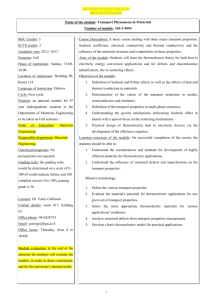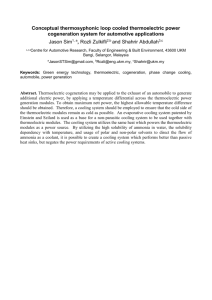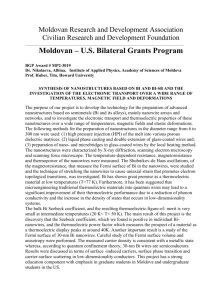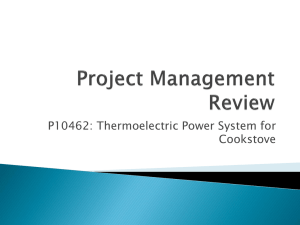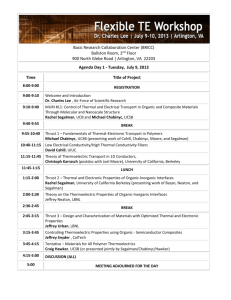Energy cook stove for off grid rural areas
advertisement
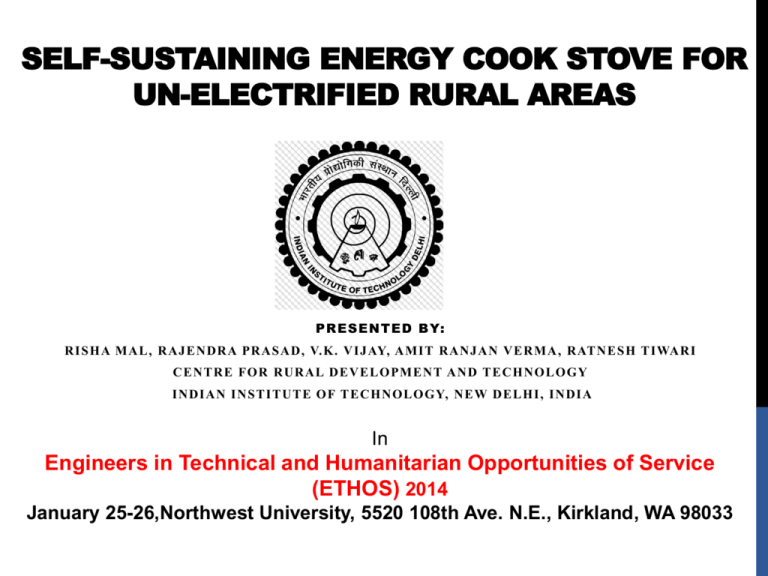
SELF-SUSTAINING ENERGY COOK STOVE FOR UN-ELECTRIFIED RURAL AREAS PR ESENTED B Y: RI S H A MAL , RAJE NDRA PRAS AD, V.K. VIJAY, AMIT RANJAN VE RMA , RAT NE S H T I WARI CE NT RE FO R RURAL DE VE L O PME NT AND T E CH NO L O GY INDIAN INS T IT UT E O F T E CH NO L O GY, NE W DE L H I, I NDI A In Engineers in Technical and Humanitarian Opportunities of Service (ETHOS) 2014 January 25-26,Northwest University, 5520 108th Ave. N.E., Kirkland, WA 98033 POPULATION DISTRIBUTION IN INDIA The Rural and Urban population in India was last reported at 69.90 and 30.1 (% of total population) respectively in 2010, according to a Indian Census published in 2011. The growth rate of population in rural and urban areas was 12.18% and 31.80% respectively. INDIAN RURAL SCENARIO OF COOKING People have gadgets like mobile, motor bike, TV etc, and use sanitary toilets but still use mud stove for cooking!!!!! We need to bridge the gap by technology on stoves with multiple applications to make it acceptable. HEAT LOSSES Utilization of the waste heat POWER GENERATION There are 2 modes of Power generation from a thermoelectric module Works as a cooler ,which can also work as a generator(proposed by D.M Rowe) Peltier Module TE module Both works vice versa Seebeck Module Works as a generator, which can also work as a cooler PELTIER COUPLE Heat Released N-type Bi₂Te₃ Electron Flow - - + + p-type Bi₂Te₃ - + - + + ++ Heat Absorbed Hole Flow SEEBECK COUPLE Cold Side N-type Bi₂Te₃ Electron Flow - - + - + + + + + + Hot Side Load p-type Bi₂Te₃ Hole Flow MATERIALS 1. The TE couples are connected electrically in series because a single couple produce power in mW, series connection of couples increase the overall voltage generated. They are connected thermally in parallel to reduce the lattice conductivity so that the cold side remains cooler. 2. Semiconductor materials consisting of p-type(excess holes) and ntype(excess e-) are used for fabrication because if two couples consist of metal the voltages gets cancelled by each other resulting in very low power. 3. For generator, the suggested materials for TEG fabrication are PbTe, SiGe, TAGS, Inorganic clathrates, Magnesium group IV compounds, Skutterudite thermoelectrics, Oxide thermoelectrics, Half Heusler alloys and many more. 4. Commercially available TEG are of Bi₂Te₃ with temperature tolerance of 250˚C with Figure of merit (ZT)=1. The PbTe modules are also available in the market with high temperature tolerance of 600 ˚C. POTENTIAL MARKETS OF COMMERCIAL TE MODULES There are many companies of TEG manufacturer. Some of them can be listed with their high power module: Company Name 𝑻𝒉 𝑻𝒄 𝑽𝒐𝒄 Efficiency(%) Power Marlow Industries Inc., USA 230 30 9.56 5.03 2-7.95 Thermonamic Electronics (Jiangxi) Corp., Ltd,China 250-300 30 14.4 - 14.4 Hi-Z Technology, USA 250-400 50 20 4.98 20 Tellurex, USA 250-320 50 8.6 - 14.1 PRIOR STOVE RESEARCHES SUMMARY Authors Type of cooling Type module J.C Bass,Killander 1966 Forced air cooling Seebeck 2 4.76 V stepped up to 13.5V Nuwayhid 2003 Natural air cooling Peltier 1 1W Nuwayhid 2005 Natural air cooling Seebeck 4 4.2W Lertsatitthanakorn 2007 Natural air cooling Seebeck 1 2.4W Mastbergen 2007 Forced cooling(1W) air Seebeck 1 +4 W Biolite 2009 air Seebeck 2 +2W Champier “TEGBioS” 2009 Forced cooling(1W) Water cooling Seebeck 2 5W “TEGBioSII” Water cooling Seebeck 4 9.5W 7.5W regulated Rinalde 2010 Forced air cooling Seebeck 2 10W RTI TECA 2010 Forced cooling(1W) Seebeck NM 1W Champier 2009 air of No. modules of Power/module BENCHMARK TESTING Cooking pot Power supply Battery Cold sink TEG Glasswool is omitted for simplicity Heat Plate Temperature regulation nobe PROTOTYPE TESTING HZ-9 module is selected for this operation due to high temperature tolerance, low cost of 20$ per module when taken in bulk of 10K. Cost of electronics sink of $ 20 and hot/cold Cost of the cookstove will be not more than $48/ 3000INR COMPARISON OF PELTIER MODULES (TEC) WORKING AS SEEBECK GENERATOR (TEG) Modules 𝑻𝒉 (˚C) 𝑻𝒄 (˚C) 𝑽𝒐𝒄 (V) Power(W) Cost($)/module Peltier module 150 55 1.5 0.5 12 HZ-14 200 100 0.7 3 45 HZ-9 200 100 2.8 3 80 ** Factor of pressure between the hot and cold side of the modules should be maintained. VOLTAGE BOOST The voltage that is generated is not sufficient for powering mobile charging or lighting a torch. A DC-DC boost converter is connected to boost the input voltage from 0.9 V to output stable voltage of 5 V. Work on ultra low power input voltage of 40mV and output stable voltage of 5 V DC-DC converter is still on progress. Fig: 1. HZ-9 (cold side), 2. ceramic wafers, 3. benchmark testing with TERI mud stove with fan running by TEG, 4. cold sink type, 5. Hot side heat collecting plate + TEG mounted for bench mark testing. 6. LED glowing by TEG+DC-DC converter, ROAD MAP 1. Appropriate TEG has been selected for operation. 2. Hot side heat collecting plate have been designed. 3. Cold side sink modeling is yet to be done. 4. Bench mark testing of TEG and running different appliances with TEG + battery + DC-DC converter on testing phase. 5. Forced draft Stove designing is in progress. 6. TEG is yet to be placed on the stove with proper temperature determination of the stove. 7. Our Goal is to develop a fully self sustaining forced draft cook stove and running a light/mobile. Prototype ready in 3 months ILLUMINATING PROSPECTIVE RURAL HOME BY COOKSTOVE USING TEG REFERENCES Books [1] H.J. Goldsmid Introduction to Thermoelectricity, Methuen Monograph, London, 1960. [2] D.M. Rowe ‘Handbook of Thermoelectrics’, CRC Press. [3] Schott Lee, ‘Thermal Design Heat Sinks Thermoelectrics Heat Pipes Compact Heat Exchangers and Solar Cells’ [4] Rowe, D. M., Bhandari, C. M., Modern Thermoelectrics. London, Holt Rinehart and Winston, 1983 Journals [5] Killander A, Bass JC. A stove-top generator for cold areas. In: Proceedings of the15th international conference on thermoelectrics; 1996 Mar 26–29; New York, USA. New York: IEEE; 1996. [6] Mastbergen D. Development and optimization of a stove-powered thermoelectric generator. Colorado State University; 2008. [7] Champier D, Bedecarrats JP, Kousksou T, Rivaletto M, Strub F, Pignolet P. Study of a TE (thermoelectric) generator incorporated in a multifunction wood stove. Energy 2011;36:1518–26. [8] Champier D, Bedecarrats JP, Rivaletto M, Strub F. Thermoelectric powergeneration from biomass cook stoves. Energy 2010;35:935–42. [9] Cedar, Jonathan M. (Scarsdale, NY, US), Drummond, Alexander H. (Austin, TX, US),"Portable combustion device utilizing thermoelectrical generation",8297271, 2012, http://www.freepatentsonline.com/8297271.html [10] David Michael Rowe , Thermoelectric waste heat recovery as a renewable energy source, International Journal of Innovations in Energy Systems and Power, Vol. 1, no. 1 (November 2006) [11] David Stokes, Michael Mantini, Ryan Chartier, Charles Rodes,’ Design and Testing of a Thermoelectric Enhanced Cookstove Add-on (TECA) for Indigenous Biomass Stoves in Kenya’RTI International,2009. [12] Nuwayhid, R.Y., Hamade, R., 2005. Design and testing of a locally made loop-type thermosyphonic heat sink for stove-top thermoelectric generators. Renew. Energy 30, 1101–1117. [13] Nuwayhid, R.Y., Rowe, D.M., Min, G., 2003. Low cost stove-top thermoelectric generator for regions with unreliable electricity supply. Renew. Energy 28, 205–222. [14] Min, G., Rowe, D. M., “Optimization of Thermoelectric Module Geometry for ‘Waste Heat’ Electric Power Generation,” Journal of Power Sources, Vol. 38, 1992, 253-259 [15] Lertsatitthanakorn C. Electrical performance analysis and economic evaluation of combined biomass cook stove thermoelectric (BITE) generator. Bioresource Technology 2007;98:1670–4. [16] Rowe DM. Thermoelectric waste heat recovery as a renewable energy source. International Journal of Innovations in Energy Systems and Power 2006;1(1). [17] Rida Y. Nuwayhid, Alan Shihadeh , Nesreen Ghaddar,’ Development and testing of a domestic woodstove thermoelectric generator with natural convection cooling’, Energy Conversion and Management 46 (2005) 1631–1643 [18] S.M. O’Shaughnessy , M.J. Deasy , C.E. Kinsella , J.V. Doyle , A.J. Robinson, ‘Small scale electricity generation from a portable biomass cookstove: Prototype design and preliminary results’ Applied Energy, 2012.07.032. THANK YOU

